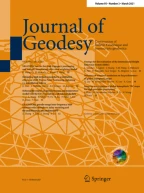Abstract.
The solutions of the CODE Analysis Center submitted to the IGS, the International Global Position System (GPS) Service for Geodynamics, are based on three days of observation of about 80–100 stations of the IGS network. The Earth rotation parameters (ERPs) are assumed to vary linearly over the three days with respect to an a priori model. Continuity at the day boundaries as well as the continuity of the first derivatives are enforced by constraints. Since early April 1995 CODE has calculated a new ERP series with an increased time resolution of 2 hours. Again continuity is enforced at the 2-hours-interval boundaries. The analysis method is described, particularly how to deal with retrograde diurnal terms in the ERP series which may not be estimated with satellite geodetic methods. The results obtained from the first year of data covered by the time series (time interval from 4 April 1995 to 30 June 1996) are also discussed. The series is relatively homogeneous in the sense of the used orbit model and the a priori model for the ERPs. The largest source of excitation at daily and sub-daily periods is likely to be the effect of the ocean tides. There is good agreement between the present results and Topex/Poseidon ocean tide models, as well as with models based on Very Long Baseline Interferometry (VLBI) and Satellite Laser Ranging (SLR) data. Non-oceanic periodic variations are also observed in the series. Their origin is most probably a consequence of the GPS solution strategy; other possible sources are the atmospheric tides.
Similar content being viewed by others
Author information
Authors and Affiliations
Additional information
Received: 13 July 1999 / Accepted: 21 March 2000
Rights and permissions
About this article
Cite this article
Hefty, J., Rothacher, M., Springer, T. et al. Analysis of the first year of Earth rotation parameters with a sub-daily resolution gained at the CODE processing center of the IGS. Journal of Geodesy 74, 479–487 (2000). https://doi.org/10.1007/s001900000108
Issue Date:
DOI: https://doi.org/10.1007/s001900000108
